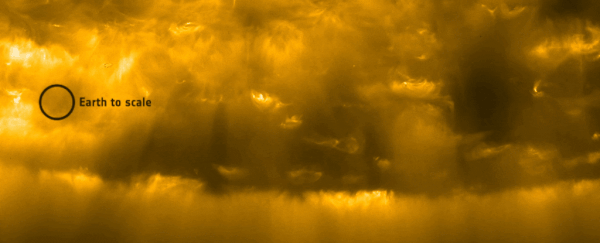A spacecraft looping around the Sun has made its first close approach – and filmed the encounter in glorious detail.
The European Space Agency's (ESA) Solar Orbiter entered the close encounter, known as perihelion, on 26 March, coming in at a distance of around 48 million kilometers (30 million miles), inside the orbit of Mercury.
At that proximity, temperatures reached around 500 degrees Celsius (930 degrees Fahrenheit). Future perihelions are expected to get even closer and hotter.
As it swooped around its orbit, the spacecraft saw the Sun as we have never seen it before – including a fascinating, mysterious feature nicknamed a 'hedgehog', and detailed views of the usually hidden solar poles.
These new observations, taken with Solar Orbiter's 10 scientific instruments working together for the first time, should provide a wealth of data for teasing out the behavior of the Sun, including its wild magnetic fields, and the sometimes chaotic weather it blasts out into interplanetary space.
We already saw a spectacular, high-resolution image from the spacecraft as it made its close approach. Now ESA has released video of the encounter, for a solar probe's-eye view of our magnificent star.

Solar Orbiter is set to make a huge difference to solar science, not least because it can show us parts of the Sun we can't usually see. For example, because of Earth's vantage point in orbit around the sun's equator, its poles are extremely difficult to study; only a spacecraft orbiting above and below the Sun can see those regions.
The polar regions are thought to be extremely important regions for the solar magnetic fields that play such a huge role in solar activity. However, because the poles are so hard to see, we don't know what happens to the magnetic fields there. With its suite of instruments, Solar Orbiter offers unprecedented insight into these enigmatic regions.
Its view of the solar south pole on March 30 revealed a region seething with looping magnetic field lines arcing away from the Sun.

The solar 'hedgehog' is another fascination. It, too, was captured on 30 March, and solar physicists are yet to figure out exactly what it is, and how it formed. It consists of a relatively small region about 25,000 kilometers across, imaged in extreme ultraviolet to reveal the activity therein.
And what activity: hot and less hot spikes of solar gas are sticking out in all directions in the solar corona, or atmosphere, like solar bedhead.
"The images are really breathtaking," says solar physicist David Berghmans of the Royal Observatory of Belgium.
"Even if Solar Obiter stopped taking data tomorrow, I would be busy for years trying to figure all this stuff out."

Solar Orbiter's main objective is to help scientists understand the effect the Sun has on the entire heliosphere, or the sphere of solar influence defined by the solar wind, whose boundary lays out beyond the orbit of Pluto. That solar wind blows particles and magnetic fields out into interplanetary space, tangling with the planets with tangible effects.
The closer Solar Orbiter approaches the Sun, the better it will be able to sample how the solar wind blows. As it drew near perihelion, on 21 March, it detected an outflow of energetic particles, and even from this distance, the detection was revealing. The more energetic particles arrived first, followed by the less energetic ones. This suggested that the particles were not produced near Solar Orbiter's position, but close to the surface of the Sun.
Other instruments picked up solar events that could have produced the particles, accelerating them out into space, including a solar flare and coronal mass ejection, not dissimilar to a CME observed by the spacecraft on 10 March, seen below.

The Sun is currently quite active, which means the spacecraft is going to be beaming home absolute bucketloads of valuable data on solar activity. It has at least 14 more perihelions scheduled before 2030, in which it will swoop as close as 40 million kilometers from the Sun, using Venus flybys to boost its speed as it whirls around.
This first perihelion, so rich with new data and observations, is a tantalizing taste of the solar bonanza to come.
"We are so thrilled with the quality of the data from our first perihelion," says solar physicist Daniel Müller, ESA Project Scientist for Solar Orbiter.
"It's almost hard to believe that this is just the start of the mission. We are going to be very busy indeed."
